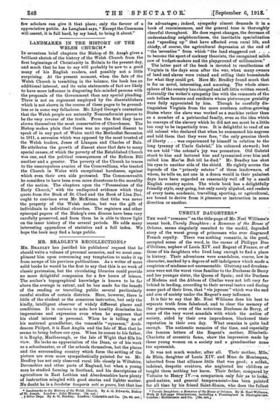LANDMARKS IN THE HISTORY OF THE WELSH CHURCH.* Ix seventeen
brief chapters the Bishop of St. Asaph gives a brilliant sketch of the history of the Welsh Church from the first beginnings of Christianity in Britain to the present day, and much that he has to say will probably be new to a good many of his English readers, and possibly not a little surprising. At the present moment, when the fate of the Welsh Church is trembling in the balance, the book has an additional interest, and its calm statements of fact are likely to have more influence in disgusting fair-minded persons with the proposals of the Government than any special pleading. There is not an argument employed by the disestablishers which is not shown in the course of these pages to be ground- less or in some way fallacious. Mr. Lloyd George's contention that the Welsh people are naturally Nonconformist proves to be the very reverse of the truth. From the first they have shown themselves the most conservative of Churchmen. The Bishop makes plain that there was no organized dissent to speak of in any part of Wales until the Methodist Secession in 1811, a secession which was opposed by the most trusted of the Welsh leaders, Jones of L]angan and Charles of Bala. He attributes the growth of dissent since that date to many special causes, of which the poverty of the Established Church was one, and the political consequences of the Reform Bill another and a greater. The poverty of the Church he traces to the unscrupulous avarice of the Cromwellians, who treated the Church in Wales with exceptional harshness, against which even their own side protested. The Commonwealth he considers to have been even more disastrous to the morality of the nation. The chapters upon the "Possessions of the Early Church," with the undisputed evidence which they quote from the Book of St. Chad and the Book of Llan Day, ought to convince even Mr. McKenna that tithe was never the property of the Welsh nation, but was the gift of individuals to individual churches. The registers and other episcopal papers of the Bishop's own diocese have been very carefully preserved, and from them he is able to throw light on the inner history of the several periods. He adds many interesting appendices of statistics and a full index. We hope the book may find a large public.






































 Previous page
Previous page